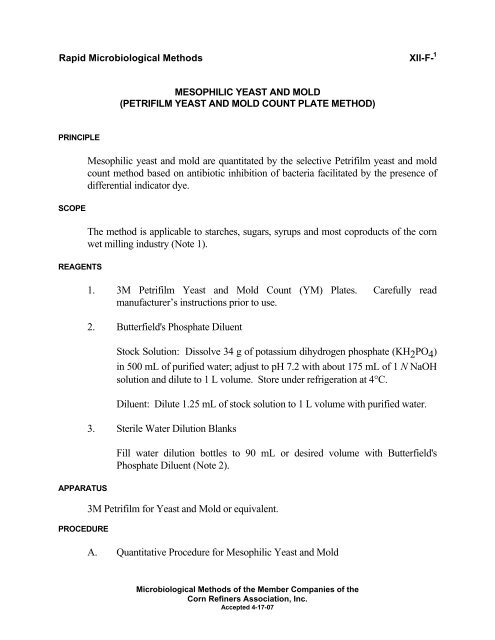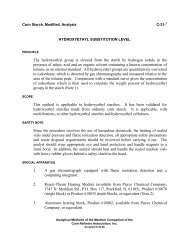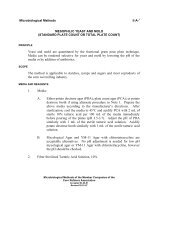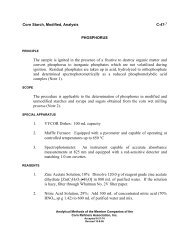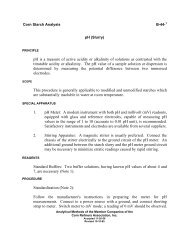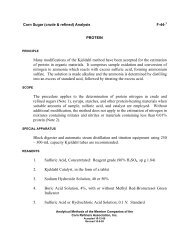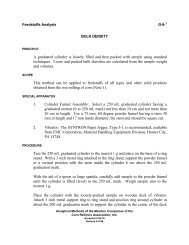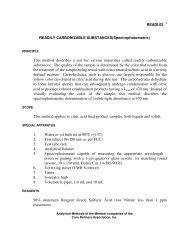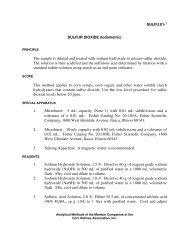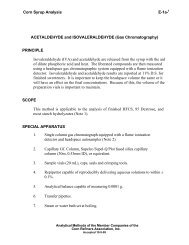PETRIFILM YEAST AND MOLD - Corn Refiners Association
PETRIFILM YEAST AND MOLD - Corn Refiners Association
PETRIFILM YEAST AND MOLD - Corn Refiners Association
- No tags were found...
Create successful ePaper yourself
Turn your PDF publications into a flip-book with our unique Google optimized e-Paper software.
Rapid Microbiological Methods XII-F- 1MESOPHILIC <strong>YEAST</strong> <strong>AND</strong> <strong>MOLD</strong>(<strong>PETRIFILM</strong> <strong>YEAST</strong> <strong>AND</strong> <strong>MOLD</strong> COUNT PLATE METHOD)PRINCIPLESCOPEREAGENTSAPPARATUSPROCEDUREMesophilic yeast and mold are quantitated by the selective Petrifilm yeast and moldcount method based on antibiotic inhibition of bacteria facilitated by the presence ofdifferential indicator dye.The method is applicable to starches, sugars, syrups and most coproducts of the cornwet milling industry (Note 1).1. 3M Petrifilm Yeast and Mold Count (YM) Plates. Carefully readmanufacturer’s instructions prior to use.2. Butterfield's Phosphate DiluentStock Solution: Dissolve 34 g of potassium dihydrogen phosphate (KH 2 PO 4 )in 500 mL of purified water; adjust to pH 7.2 with about 175 mL of 1 N NaOHsolution and dilute to 1 L volume. Store under refrigeration at 4°C.Diluent: Dilute 1.25 mL of stock solution to 1 L volume with purified water.3. Sterile Water Dilution BlanksFill water dilution bottles to 90 mL or desired volume with Butterfield'sPhosphate Diluent (Note 2).3M Petrifilm for Yeast and Mold or equivalent.A. Quantitative Procedure for Mesophilic Yeast and MoldMicrobiological Methods of the Member Companies of the<strong>Corn</strong> <strong>Refiners</strong> <strong>Association</strong>, Inc.Accepted 4-17-07
Rapid Microbiological Methods XII-F- 2MESOPHILIC <strong>YEAST</strong> <strong>AND</strong> <strong>MOLD</strong><strong>PETRIFILM</strong> <strong>YEAST</strong> <strong>AND</strong> <strong>MOLD</strong> COUNT PLATE METHOD) ⎯ continuedCALCULATION1. Prepare decimal dilutions by aseptically weighing 10 g of sample into90 mL sterile diluent (Note 3). The sample is further diluted by factor10 dilution series, if high counts of yeast and mold are anticipated.2. Place the YM plates on a flat surface. Lift top film and dispensecarefully 1 mL of the sample dilution to the center of bottom film.Carefully roll down the top film onto the sample to prevent theentrapment of air bubbles. Distribute sample evenly within the circularwell using the plastic spreader. Let plate stand undisturbed for oneminute to permit gel hydration and solidification.3. Incubate the plates in stacks (20 maximum) at 20-25°C in a horizontalposition with the clear side up, checking after 24 and 48 hrs.4. Count yeast and mold colonies on Petrifilm YM Count plates. Anindicator dye stains yeast and mold colonies to provide contrast andfacilitate counting. Yeast will be characteristically small, blue-greencolonies with defined edges and no foci. Mold will be characteristicallylarge, variable colored colonies with diffuse edges and center foci.Record the results and calculate the number of yeast/mold per gram ofsample (Note 4).Number of yeast/mold per g = Average number of yeast/mold × Dilution Factor.NOTES <strong>AND</strong> PRECAUTIONS1. Although the Petrifilm method is approved by AOAC for all foods, use of themethod for highly osmophilic samples should be carefully evaluated againstthe conventional method for performance verification. A suggested procedurewould be to prewet as follows: Place the plate on a flat surface. Carefully liftthe top film and wet the center of the bottom film with 1.0 ml of sterile water.Release the top film onto the bottom film with a “rolling down” motion toprevent air bubbles from forming within the plate. Place the plate spreader onthe top film and gently press in a downward motion to evenly distribute thesterile water on the bottom film. Allow the plate to gel for 1-2 hours. To
Rapid Microbiological Methods XII-F- 3MESOPHILIC <strong>YEAST</strong> <strong>AND</strong> <strong>MOLD</strong><strong>PETRIFILM</strong> <strong>YEAST</strong> <strong>AND</strong> <strong>MOLD</strong> COUNT PLATE METHOD) ⎯ continuedREFERENCEsupport reliable results for highly osmophilic samples, a correspondingMesophilic Yeast and Mold test should be also run for performanceverification.2. When sterilizing dilution blanks a portion of the diluent may be lost. Whenthis occurs, the sterilized blanks are brought to the proper volume with thesterile diluent.3. When running counts on pregelatinized starches, no more than 5 g of sampleper 95 mL of diluent may be used.4. Some raw and processed food products that contain living cells (and therefore,phosphatase) may also cause this blue color reaction to occur. Two types ofcolor reactions from products are sometimes seen: a uniform blue backgroundcolor, or intense, pinpoint blue spots (often seen with spices or granulatedproducts). See manufacturer's directions.<strong>Association</strong> of Official Analytical Chemistry, www.aoac.org.


